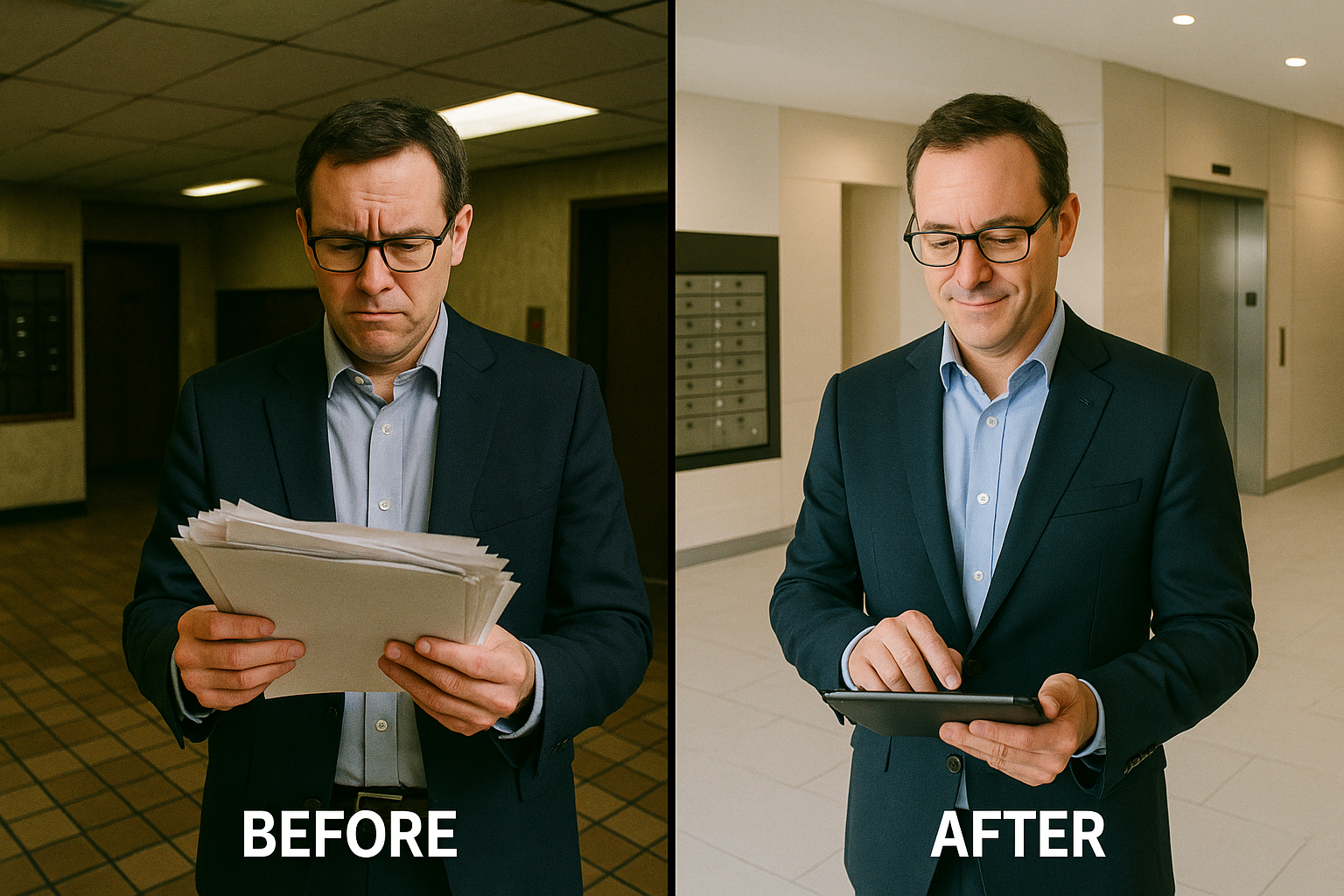On September 2, 2025, Cove hosted a webinar featuring Adam Segal, CEO of Cove, and Tanya Graves, SVP of Marketing at TMG that surfaced practical, hard-won insights about commercial property management. The discussion focused on what actually moves the needle on occupancy, renewals, and day-to-day operations.
If you manage an office, mixed-use, or campus asset, you’ll recognize discussion around parking friction, scattered tools, underused amenities, and slow adoption of new tech.
Let’s dig into the takeaways: how to centralize tenant tasks, program spaces people will use, remove bottlenecks around parking and access, measure the right metrics, and align property teams and brokers around one story.
Set the Stage: What Your Tenants Expect Now
You’re no longer competing on a checklist of tenant amenities. You’re competing on the quality of the experience and how easy it is for people to move through their day. Tenants want access to transit, dining, fitness, outdoor space, and they want those options on the doorstep. Even in mixed-use districts where options are outside the door, you still need on-site convenience that feels intentional.
Quality beats quantity. A conference center that actually works for an off-site, a terrace where someone can answer email without squinting into the sun, wellness elements that people use rather than photograph—these details shape satisfaction. You “amenitize the amenity” through service and technology with a hospitality mindset. When design, operations, and tech pull in the same direction, your building becomes the easy button for a workday.
The frictionless piece matters most. Access control, reservations, parking, work orders, and communications should live in one place with real-time visibility. The old pattern of office manager emails property management and waits isn’t sustainable. Tenants should complete tasks on their phone in a few taps and get back to their day.
Hybrid Work Changed Behaviors, Flexibility Keeps
People Coming Back
You’ve seen it across markets: hybrid is here, and it’s more about flexibility than a fixed number of days. Many tenants are nudging attendance up, but they hesitate to over-commit to space, parking, and schedules. Your advantage comes from building flexibility into the entire experience: leasing options, spec suites, amenity access, and parking rules.
TMG makes flexibility tangible with spec suites across the portfolio and amenity designs that let companies scale up or down. That shortens time-to-start for new tenants and gives current tenants reasons to renew. It also supports the “commute value” mindset: if people come in, what else can they check off during the day? Fitness classes, errands, or programming that adds personal value make the trip feel worth it.
You can apply the same principle to micro-decisions like day-to-day parking. When you handle high-demand days with dynamic availability and shared reservation logic, you remove a friction point that quietly blocks attendance.
Parking: The Unseen Lever for Occupancy
Parking is where you win or lose many office days. Ratios are often outside your control, yet you get the questions anyway: “How do I bring 50 people to a building with 20 spots?” A static monthly contract won’t solve that.
What works: flexible, tech-supported allocation. Give tenants live insight into availability, make it easy to reserve, and let teams share a pool of spots. The result is a clear plan on high-demand days and less back-and-forth for your managers. As Tanya put it, a beautifully renovated lobby won’t matter if people can’t get a place to park. Treat parking like a core part of the experience and manage it with the same rigor you bring to work orders and access.
Action you can take:
- Map demand by day and hour for 6–8 weeks. You’ll see peaks that justify a flexible policy.
- Pilot a shared-pool model with one tenant. Measure fill rates and no-shows before you expand.
- Publish simple rules in your tenant app: when reservations open, how long they hold, and what happens on waitlists.
Centralize the Experience: One App, Fewer Logins,
Faster Tasks
If you make tenants memorize five portals and six passwords, adoption will drag. The more you centralize, the faster everything moves. TMG prioritized a unified commercial property management software and dashboard so access control, work orders, amenity reservations, parking, and communications live together, and so does the real-time data. That helps your tenants complete tasks quickly and gives your teams time back for true customer service.
A practical adoption insight: bundle “must-do” tasks with “nice-to-have” perks to build momentum. When someone opens your app for a parking reservation and also sees an on-site retail offer or a building event, they form a habit that sticks. Adoption isn’t just a login metric; it’s a path to better data, better response times, and better renewals.
Action you can take:
- Put your highest-volume tasks on the first screen and cut the taps in half.
- Pair a required task (e.g., access setup) with a perk (e.g., tenant-only retail discount).
- Set a goal to reach individual employees, not just the office manager. That widens feedback and keeps communications honest.
What Falls Flat (So You Can Avoid It)
You’ve probably lived this: standalone tools with extra logins rarely stick. If a solution can’t integrate into your central hub, effort piles up for managers and tenants. You also lose sight of usage data across the whole experience.
Before you green-light a new tool, ask one question: “Will this live in our app and feel like one experience?” If the answer is no, proceed very carefully. The promise of a feature won’t overcome a clunky path to use it.
Action you can take:
- Add “must integrate with our app” to your vendor scorecard.
- Run a 30-day sandbox with a small group of managers and two tenants. If setup or support takes heroic effort, move on.
- Keep a running “do not repeat” list of tools that added effort without clear impact.
Property Teams: Make Them the Champions,
Not the Backstop
Technology succeeds when your on-site teams see it as a time-saver, not an extra chore. TMG pairs head of property management with marketing at the decision table and taps a handful of managers to provide real-time feedback during rollouts. That turns managers into champions and aligns incentives: faster response times, cleaner reporting, and portfolio-level visibility that reflects well on the team.
Centralization helps here, too. When you unify operations across buildings, your managers spend less time on swivel-chair work and more time with tenants. Ownership gets apples-to-apples reporting, and your data feeds a better leasing story.
Action you can take:
- Recruit a “manager advisory group” from three buildings to preview changes and flag friction.
- Tie team metrics to outcomes technology improves: first response time, time-to-close, amenity utilization, satisfaction.
- Share impact back to teams every month. People support what they help build.
Amenities People Actually Use: Program the Space,
Not Just the Look
A stunning photo won’t move your occupancy if the room doesn’t work. Start with functionality: power where people sit, Wi-Fi that connects fast, blinds where the sun hits, sightlines that make a large room feel natural for small groups. Then layer in programming that reminds people the space exists and invites them back.
TMG’s approach blends design with consistent activation—pop-ups, workshops, seasonal experiences—and removes the little frictions that keep people at their desk. The reservation experience needs the same care. Make it clear what’s available, how to book, and what to expect on arrival.
Action you can take:
- Walk the space at 10 a.m., 1 p.m., and 4 p.m. with a clipboard. Note power access, glare, noise patterns, and traffic flow.
- Put the Wi-Fi name and QR code on tasteful signage where people naturally look.
- Set an “activation cadence” for each asset (weekly in one, monthly in another) and publish it in your tenant app.
A Simple Change with Outsized Impact:
The Rooftop Garden
Sometimes the win is delight. TMG turned an underused rooftop/garage area into a garden with a local partner, then brought the harvest into lobbies on a monthly rotation. Tenants get fresh produce and herbs grown on-site. Technology ties it together with reminders and notifications, and the program builds a cross-building community rhythm.
It’s low-cost and high-touch. It also signals that you’re investing in daily life, not just square feet. You can replicate the idea with other themes—rotating local makers, lunchtime wellness, seasonal markets—anchored by consistent communications through your tenant experience platform.
Action you can take:
- Identify one underused space and one local partner with a strong story.
- Pilot a 90-day program with a clear schedule. Announce it in-app and follow up the day of.
- Track participation and feedback, then decide whether to add buildings to the rotation.
Turning Experience into Leasing Outcomes
Experience pays off when it shows up in rent growth, renewals, and tours that convert. TMG integrated one Tysons asset into a district ecosystem—shared amenities, curated spec suites, strong branding—and drove rents up by roughly 22% over its hold period while securing key renewals before sale. The lesson for you is to connect building-level improvements to a neighborhood-level story and back it up with usage data.
Brokers need that story, too. TMG keeps marketing, leasing, and property management at the same table so the pitch is consistent: here’s how people use the amenities; here’s the utilization curve by hour; here’s how service response times improved; here’s how district programming adds value. That level of detail changes how a tour feels and gives tenants confidence about the day-to-day.
Action you can take:
- Build a “Leasing Data One-Pager” for each asset: work-order response times, amenity bookings by hour, parking fill by weekday, event engagement, and a short case note from one tenant.
- Invite brokers to two experiences per quarter and show them how to book spaces through the app. Familiarity turns into better storytelling.
- Bring ownership, property management, and leasing into quarterly anchor-tenant meetings. You’ll surface expansion signals and space-givebacks earlier.
Measure What Matters (So You Can Improve What
Matters)
Three categories keep you honest:
- Operations quality: first response time, time-to-close, request types, and volume trends by tenant. These numbers prove whether tech and process actually help teams move faster.
- Utilization: reservations by hour, space occupancy, and conversion from “seen to used.” This is your lever for programming and renewals.
- Engagement: event participation, message open rates, adoption metrics at the individual employee level. This widens your feedback loop beyond one office manager’s inbox.
Turn these into a standard dashboard, review them monthly, and tell the story back to tenants and brokers. Data becomes a marketing asset when you use it to show progress over time.
Implementation That Sticks: Teach, Remind, and
Make It Easy
Behavior change takes time. You’ll see faster adoption when you vet the experience up front, create simple how-tos, and repeat your message across formats. Live demos help, but follow-up videos and step-by-step guides move more people over the hump. Large tenants sometimes need their own workshop. Aim for multiple touchpoints over several weeks and accept that it will take longer than you want.
A roadmap also helps. Roll out enough features that tenants feel a real benefit on day one, then show what’s coming next. When people know the tool will grow with them, they stick with it.
Action you can take:
- Record 60-second micro-videos: “Book a room,” “Reserve parking,” “Invite a visitor.” Host them in-app.
- Send a three-message sequence for launches: “Coming soon,” “Go live,” “Quick tips.”
- Publish a simple feature roadmap inside the app with dates and owners.
Look Ahead: Where to Focus in 2025–2026
Your competitive edge will come from a unified approach that treats buildings as part of a district ecosystem. People want to be part of a place, not just a floor plate. That means stronger connections across nearby assets, shared amenities where it makes sense, and a brand experience that feels consistent.
When you invest in upgrades, aim for “plug-and-play” spaces that extend a tenant’s footprint without the tenant doing extra work. Spend less on wallpaper and more on the details that let people plug in, collaborate, present, and gather without friction.
Action you can take:
- Map a 10-minute walk around each building and list the shared experience you can credibly offer today. Close the gap with two partnerships this quarter.
- Revisit amenity spaces with a “does it work on Monday at 9 a.m.?” lens. Adjust power, Wi-Fi, shading, and signage before your next photo shoot.
- Tie every capex request to a usage or leasing metric you can track within 90 days of completion.
A Practical Playbook You Can Start This Quarter
1) Centralize tasks. Put access, parking, work orders, reservations, and communications in one mobile-first hub. Reduce taps on your top three tasks by half.
2) Bundle value. Pair must-do tasks with perks and programs. Use app notifications to build habit loops tied to real activity in the building.
3) Fix parking friction. Pilot a shared-pool reservation model with live availability. Publish simple rules and measure fill rates, waitlist times, and no-shows.
4) Design for use. Audit amenity functionality (power, Wi-Fi, glare, acoustics) at peak times. Make small fixes that unlock daily usage. Then program a steady, lightweight activation cadence.
5) Empower teams. Stand up a manager advisory group, align metrics with time savings and service quality, and celebrate wins with data.
6) Tell the story. Build a leasing one-pager with operations metrics, utilization curves, and engagement highlights. Put marketing, leasing, and property management in the same meeting so the narrative stays tight.
7) Teach and remind. Launch with simple how-tos, short videos, and tenant-specific workshops where needed. Expect a runway and plan communications accordingly.
Final Thought: Make the Building the Easy Choice
When you lower friction across tasks, make spaces that actually work, and back it all with consistent communications, you give people reasons to come in, and reasons to stay. You also give your teams time to be present with tenants, which is the real engine of renewals. Start with one lever, parking, reservations, or communications, and make it excellent. Then build outward. The outcome isn’t just a better app or a nicer room; it’s a building that feels easy, useful, and worth the commute.
This conversation is just the start. We’ll continue hosting webinars with leaders across commercial real estate to share fresh strategies and practical ideas you can use in your buildings.
Want the full conversation? You can watch the complete webinar recording here to hear all of their insights on how tech-enabled operations and thoughtful tenant experiences are shaping the future of commercial properties.

.png)
.png?width=1200&height=627&name=LinkedIn%20Webinar%20%231%20Ads%20-%20August%202025%20(1).png)



